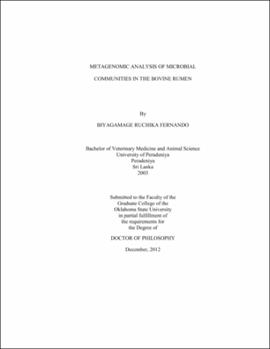| dc.contributor.advisor | DeSilva, Udaya | |
| dc.contributor.author | Fernando, Biyagamage Ruchika | |
| dc.date.accessioned | 2013-11-26T08:26:01Z | |
| dc.date.available | 2013-11-26T08:26:01Z | |
| dc.date.issued | 2012-12 | |
| dc.identifier.uri | https://hdl.handle.net/11244/6838 | |
| dc.description.abstract | Scope and Method of Study: | |
| dc.description.abstract | The mammalian gut ecosystem consists of bacteria, fungi, protozoa and viruses. The role of gut microbes in the performance and well-being of the host animal is well recognized. This study has analyzed the diversity and genomic complexity of the double stranded DNA virome of the bovine rumen. A parallel study was conducted to investigate the diversity of anaerobic fungi within the bovine rumen. Viral particles were separated from other rumen microorganisms and their DNA was amplified using a sequence-independent protocol and sequence analyzed using Roche 454 pyrosequencing technology. A PCR-based assay was developed using conserved genomic regions specific to anaerobic fungal communities and amplified PCR products were sequence analyzed using next-generation sequencing technology. | |
| dc.description.abstract | Findings and Conclusions: | |
| dc.description.abstract | Only 26.6% of the putative viral sequences could be annotated using the information present in the public databases. Out of this, about 14% of the sequences had homology to previously described viruses and a vast majority of the rest were classified as bacterial sequences. These bacterial sequences probably represent proviral sequences found in already sequenced bacterial genomes or some of the lytic phage particles isolated in this study that carry genetic information acquired from their hosts. Interestingly, the distribution of bacterial hits was similar to the relative abundances of these bacteria described in the rumen environment. About 85% of the viral hits corresponded to tailed bacteriophages belonging to Siphoviridae (69.8%), Myoviridae (13.8%), and Podoviridae (1.5%). The gene ontology studies of the putative viral sequences revealed that these viruses carry a diverse array of genes related to a range of virus specific and non-virus specific functions. Further, the findings of this study suggest the presence of CpG methylation in the rumen virome which needs to be further investigated. | |
| dc.description.abstract | A high level diversity was observed among anaerobic fungi of the bovine rumen. Only 23.7% of the sequences could be annotated to previously described anaerobic fungi and 74.9% were found to be from new species-level operational taxonomic units. Further, we found evidences for the presence of novel genera (~1.5%) of anaerobic fungi in the rumen. In animals fed with a high protein, hay-based diet, the genus Orpinomyces (41.6%) was the most abundant followed by Anaeromyces (29.7%), Neocallimastix (13.9%), Piromyces (10.2%), Caecomyces (2.9%) and Cyllamyces (0.1%). The PCR primers designed in this study did not amplify any plant or other fungal DNA which has been a problem with many previously published primers. | |
| dc.format | application/pdf | |
| dc.language | en_US | |
| dc.rights | Copyright is held by the author who has granted the Oklahoma State University Library the non-exclusive right to share this material in its institutional repository. Contact Digital Library Services at lib-dls@okstate.edu or 405-744-9161 for the permission policy on the use, reproduction or distribution of this material. | |
| dc.title | Metagenomic analysis of microbial communities in the bovine rumen | |
| dc.contributor.committeeMember | Krehbiel, Clint | |
| dc.contributor.committeeMember | Mateescu, Raluca | |
| dc.contributor.committeeMember | Doust, Andrew | |
| osu.filename | Fernando_okstate_0664D_12317.pdf | |
| osu.accesstype | Open Access | |
| dc.type.genre | Dissertation | |
| dc.type.material | Text | |
| dc.subject.keywords | anaerobic fungi | |
| dc.subject.keywords | bacteriophages | |
| dc.subject.keywords | gut | |
| dc.subject.keywords | metagenomic | |
| dc.subject.keywords | rumen | |
| dc.subject.keywords | viruses | |
| thesis.degree.discipline | Animal Breeding and Reproduction | |
| thesis.degree.grantor | Oklahoma State University | |
